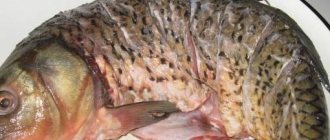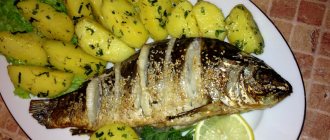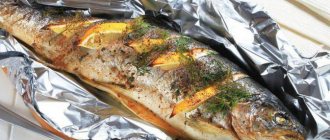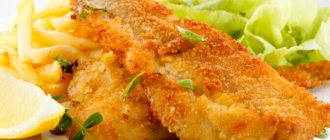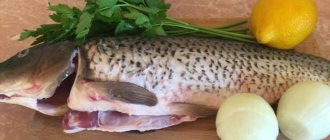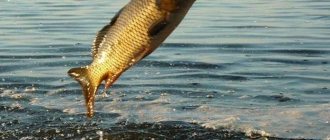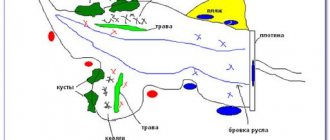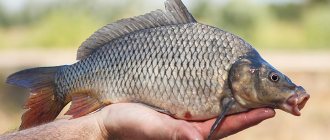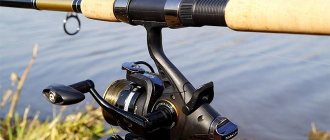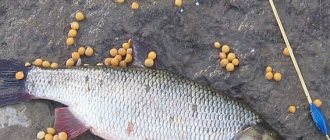Habitats of carp
Carp live in the basins of the Caspian, Baltic, as well as the Azov and Black seas. The further south you go, the earlier you can start catching carp, since this is a heat-loving fish and does not appear in the cold season. If in the southern regions the first bite is observed in April, then in central Russia the best bite is in August, when the reservoirs have already warmed up enough, and the carp that has settled in them has finished spawning and begins to respond to food before the coming cold weather. It is best to look for carp in warm bodies of water with stagnant water or a gentle, barely perceptible current. Ponds, lakes, reservoirs and small streams are well suited for this. Carp often lives near steep banks and pools. It bites best from a clay or sandy bottom.
Bait for carp
Bait for carp is sold in a fishing store, but the most effective is the one you prepare yourself.
Preparing bait is not difficult, because there are many recipes.
Recipe No. 1
You need to take 5 shares of corn grains, pour boiling water over them and add salt. Next, you need to grate the boiled beets. Afterwards, cook 3 parts of rice and leave all the ingredients to cool.
After the ingredients have cooled, you need to mix them in a bowl, and then add hemp and bran seeds, previously crushed and fried in a frying pan.
To give the bait an alluring aroma, you need to add a small amount of linden decoction or a couple of drops of anise oil.
Recipe No. 2
You need to mix the following ingredients: crayfish meat; bloodworm; steamed turnips with salt; undercooked potatoes; garlic; old cheese; crushed flax seeds and then bait can be used for fishing purposes.
Where and when to catch carp?
If the weather is normal for August and there are no noticeable temperature changes, the carp feeds around the clock. For a good bite, the location of the reservoir in which the carp lives and the time of day at which you go fishing are important. If you fish at night, we recommend doing it in shallow water - carp most often visits it in the dark. It is impossible to say for sure which hours are best for night fishing, but experienced fishermen know that it is useless to catch this fish from one to three in the morning. In the evening or early morning (at 4-5 o’clock) the carp often appears at the edge of the reservoir to feed on small animals that come from the shore. Carp carefully avoids places where pike, pike perch and catfish are found. After sunrise, when the reservoir begins to warm up, the carp gradually swims to the depths. At 9-10 o'clock in the morning you can catch a very good bite if you move to the northwestern sections of the coastline - to places that have already been warmed up by the sun and which carp usually visits in the morning. During the day, only small carp bite, and not always, but closer to 6 pm this fish can be caught if you fish from a boat in calm, well-warmed places. Catching carp in August has a number of features, one of them is its dependence on the weather. If there is extreme heat, despite all its heat-loving nature, the carp will not bite. He also does not like strong bad weather or sudden changes in weather. Warm, light rain or cloudy weather with rain is ideal for catching carp in August.
Bait for carp
For successful fishing, you need to use the right bait. It can be varied, but experienced fishermen use the following options:
- Boilies. These are balls made from an aromatic mixture that attract prey and filter out “trifles,” since only a large individual can swallow such bait. The most common of them can be called “Birdfood” (which contains bird food, dough and vegetable oil), as well as “Meat-Spice” (in the recipe: eggs, butter, vanillin and bone meal).
- Toothless. A shellfish that needs to be hooked. This bait does not sit firmly, so you should periodically pull the tackle out of the water to make sure that the toothless fish does not jump off the hook.
- Boiled potatoes. Potatoes must be cooked in a concentrated saline solution, after which the liquid must be drained. Next, the tubers should be placed in cold water and drained again in a colander. This procedure is repeated until the vegetable has cooled. Cold potatoes should be cut into pieces of 10-15 mm and placed on a hook.
- Worm and fry. They are a classic bait. With it, it is better to catch carp in deep water bodies, so that small fish do not knock the “treat” off the hook.
- Cake. The substance should be compacted into small briquettes and pressed with rubber bands onto a special lead plate identical in format to the briquette. The plate needs to be attached to the end of the main fishing line, and from the other edge, several leashes with hooks inserted into the cake plate must be attached to it.
Groundbait and bait for carp
It is in August that the opportunity arises to catch a very large, well-fed carp. Before this, small individuals are usually caught, and in mid-late September the food disappears completely. In order to lure fish, it is best to use a mixture of wheat and millet porridge, boiling them well. Steamed rye and buckwheat, rice, pearl barley or millet cooked in milk, any bread, cottage cheese or beans are also suitable. To attract large fish, tightly rolled balls of a mixture of hemp grain, steamed grain crops and clay are thrown. Under no circumstances should you consume grain that is already beginning to sour; fish will not go to such a place. The bait is thrown right at the place where they are going to fish, as well as little by little into the corners of the sector and into the depths. It is best to secure a place 10-12 hours before fishing. For successful carp fishing, the bait you use is extremely important. It is better to take several options with you, since fish often prefer one or the other. It is good to use a red dung worm for catching carp. You can choose a bait similar to bait: if you cook millet porridge so hard that it can be cut into pieces, then you can easily attach it to the hook. Rolled tight balls from a mixture of steamed wheat grains, earthworms and bread are suitable. A real delicacy for carp is boiled crayfish necks, bread and legumes. All this can be combined with wheat flour dumplings.
Lure
Modern fishing for peaceful fish is rarely complete without such an important component as bait. It is used to attract fish to the fishing point and keep it there throughout the fishing trip.
For carp, bait should be three-component:
- fine fraction to create a turbidity column;
- large particles to keep fish on point;
- flavorings to attract smell.
As a fine fraction, ready-made store-bought mixtures for any carp fish or home-made mixtures are used. To prepare baits, simple products from the supermarket are used;
- finely ground wheat crackers;
- breading mixtures;
- semolina;
- powdered milk;
- crushed cereals: corn, wheat, egg.
Large fractions of bait usually repeat the bait, following the principle: what you catch with is what you feed.
Advice! Bait elements added to bait are usually slightly reduced: crushed, split, crushed.
When adding corn grains to groundbait, mash them a little to release the juice.
To make the mixture attract fish from long distances, attractants are used. In August there is a change of purely summer sweet and fruity aromas at the beginning of the month, spicy and meaty at the end:
- vanilla;
- honey;
- strawberry;
- Tutti Frutti;
- caramel;
- anise;
- dill;
- garlic;
- maggot;
- shrimp;
- crab.
It is better not to add an attractant to all the bait at once, but to do it in portions, changing smells, gradually arriving at the most catchy option.
What is the secret of catching carp
To catch carp in August, it is best to use running tackle, since the fish not only has time to gain weight, but also become quite cautious. The first jerks of the carp after it is hooked are very sharp and strong; a blind tackle on a thin line will never survive. And since the carp is cautious, it is not possible to use a thick fishing line: then bites will be extremely rare, or you may not even get them at all. As for the fishing rod, it is better to use the most powerful and durable option possible. A stiff rod will do a great job of holding back a fish's jerks without having to let out too much line. The most convenient type would be a spinning reel with a large drum. If you fish at shallow or medium depths that do not exceed the length of the rod, then it is best to use a float rod. While holding it, be careful: if the line is loose between the rod and the float, then the fish, having swallowed the bait, will not notice resistance, which will allow the hook to fix more securely. The distance to the float should be about two meters; the same amount or slightly less fishing line will be located in the water column. If you are unable to comply with these parameters, since you are fishing at depth and from a boat, you need to use two sinkers that can hold the line at the desired level.
What to feed carp in August
When going on a “quiet hunt”, do not forget about feeding the fish. This will not only help attract aquatic life from other areas, but will also encourage them to stay in the nourishing area.
Important! When feeding carp, you should know when to stop and not allow too much food, otherwise a well-fed fish will simply ignore the bait while fishing.
You can use a ready-made mixture, which needs to be mixed with clay and formed into balls with a diameter of about 6 cm. It is also possible to make a mixed mixture for complementary feeding yourself. In this case, you must follow the instructions.
- Mix equal amounts of peas, corn, sunflower cake and wheat.
- Place all ingredients in a saucepan of boiling water.
- Cook, stirring occasionally, until the ingredients are completely cooked.
- Remove the pan from the heat, add semolina and millet in an amount equal to the other ingredients, and cover tightly.
- Once completely cooled and the clay added, the mixture is ready to use.
Does the carp bite or not?
It is usually quite simple to determine that a carp is biting. The float begins to move away at high speed, almost without plunging into the water. Sometimes, although rarely, it happens that a carp immediately drags the float to the depth immediately. If you come across a large and experienced fish, then the line may be broken: the carp takes the bait at high speed. If you see that your float is quickly sinking into the water, immediately grab it and pull the rod up with a sharp movement. If there is a significant tilt of the float to the left or right, pull in the opposite direction. After hooking, the carp will most likely quickly rush to swim to the side. This is the most dangerous moment of fishing; it is extremely easy to lose prey. By a sharp and strong turn of the rod you need to force it to go in the direction you want, dragging the fish head first. It is best to hold the fishing rod with both hands, then even a large fish will not be able to snatch it from you. At this stage, the line should not be passed through or pulled towards you. Having rushed in different directions, the carp begins to describe regular, uniform arcs, rising more and more to the surface. It is very important to let him exhaust himself and calm down. If the fish appeared on the surface or began to quickly dive into the depths, then come into the visibility zone, this indicates that the carp is not yet tired enough. When, gradually pulling the carp towards you, you see that it describes arcs less and less intensely and no longer makes impetuous movements, hold the fishing rod in this position for some more time. As soon as you notice that the carp spent several seconds immobilized, this is a sure sign that he is tired and the time has come to hook him. Then you should pull the fish towards you so that it is within the reach of your net and catch the carp in the net. In this case, the net should not be removed, gradually and carefully pulling it towards you directly through the water. Make sure your equipment is ready for both small and large catches. The net must have a long and strong handle, the fishing rod is selected according to the reservoir in which fishing is carried out (bottom in wide rivers, at depth - with a short rod, and so on). You need to use a running line, attach the sinker separately on a leash of at least one meter, or you can also put a sliding weight. The habitats preferred by carp, as well as the specifics of the bait, dictate their conditions for choosing places with a weak current or without it at all. Therefore, it is better to catch carp without long casting - if the line is only slightly extended with the current, the bait does not fly off, the bite becomes much more noticeable, and it is much more convenient to catch carp. Carp is a fairly rare and tasty fish, and its capture requires fairly high skill, great patience and attentiveness. We hope our advice will help you become the owner of a large catch that you can be proud of for a long time.
Fishing tactics
Catching carp begins with feeding a promising place. In this case, the process should begin 2-3 days before the intended fishing, and at this stage do not use gear at all, but simply lure the fish, delivering food to its feeding place. It is best to do this from a boat, since sometimes the distance from the shore to the intended fishing spot is quite large.
In some cases, throwing bait over long distances using a slingshot justifies itself.
On the Don, fishing for carp from a boat is considered the most effective. In this case, when the feeding is finished, you should stand on the boat above the feeding place, put the boat on two anchors and immediately before starting fishing, additionally throw another feeder at the feeding place. And only after this should you start casting the tackle.
In general, the tactics for catching carp are the same as for carp, with the only difference, but you should not hook the fish ahead of time
Usually the carp approaches potential prey very carefully and tries it several times. There can be up to 3–4 such “tests” within a few minutes
And it should be hooked only after the slaves securely take the bait and begin to pull it lightly.
Hooking and landing a carp is done very quickly, since a strong fish resists quite actively and can jerk sharply and escape, even severely injuring itself. The lip of the carp, like the carp, is not particularly durable and even fish that sit well on it fall off the hook is not uncommon.
Fishing for carp should be done by holding the rod vertically upward and not allowing it to straighten with the fishing line in one line. In this case, you should make movements from side to side with a small amplitude, winding the coil very quickly.
To finally get the fish out of the water, be sure to have a landing net in the boat. It is preferable for two people to get the fish, since the carp is quite massive and actively resists.
Catching a carp is a rather difficult task, requiring a fair amount of patience from the fisherman. A long period of feeding fish is one of the main criteria for the success of all fishing
Properly prepared complementary foods in the required quantities and careful behavior of the fisherman at the moment of biting - these are the conditions, the observance of which will guarantee a successful catch of carp
Read expert opinions
About the features of fishing described in the article
carp
About the features of the types of fishing described in the article
float fishing
bottom fishing
Feeder fishing
Learning how to catch carp correctly with a feeder is relatively not so simple. The wild relative of the carp is very careful and requires fairly accurate knowledge of its favorite trails and feeding places. In terms of bait, there are also some peculiarities, but you should immediately decide on the gear.
Rod
Since with the beginning of summer the carp begins to move away from coastal zones, the length of the rod should allow fishing from long distances. Feeders 3.9-4.2 meters long will be the most suitable solution. Each angler chooses the rod structure for himself, however, it should be borne in mind that medium and slow blanks better dampen the jerks of large fish, but are inferior in accuracy to fast rods, which also allow, if necessary, to force the landing, for example, in situations where you need to “pull » carp across the edge. In the case of this fish, heavy and extra heavy class feeders are used, with a test weight of 120 grams or more, since lighter options do not make it possible to throw bulky, heavy feeders over long distances.
Coil
You need a fairly large reel, at least 5000-6000 in standard size, capable of holding at least 150 meters of fishing line of a fairly large diameter. For catching carp and carp, it is also desirable to have a baitrunner - a device that will not allow strong fish to drag the tackle into the pond when biting.
It is advisable that the reel for catching carp or carp have a baitrunner. This will allow you not to worry about the safety of the gear in cases where the angler does not have time to immediately respond to a bite.
fishing line
If when catching other varieties of fish with a feeder, most anglers almost unconditionally give preference to braided line, then in the case of carp everything is not so clear. Mono fishing line also has many supporters - thanks to its stretchability, it somewhat absorbs strong jerks and to some extent simplifies fishing
The braided line does not stretch and requires more careful playing, especially just before the shore, where the carp can begin to resist with all its might.
Snaps
Both options used for catching white fish, such as symmetrical and asymmetrical loops, Paternoster or Gardner loops, as well as options with flat and method feeders can be used. The latter have some similarities with such non-sporting tackle as a nipple, macho hook or carp killer, however, the hook is usually used with flat or method type feeders.
A flat type feeder with bait, in which you can hide a hook with a nozzle.
Feeding a point when fishing for carp is an important component of successful fishing. In the case of this fish, especially when it comes to fishing in the warm season, there is no such thing as too much bait. The starting feeding should be very voluminous, at least 15 feeding feeders, otherwise when the carp approaches the point, all the food will run out very quickly and the fish will lose interest in the point. During the fishing process, you should also periodically add several feeders not only with bait, but also with an animal component.
Where does the carp live?
Carp (wild carp) is a predatory freshwater fish that is very difficult and at the same time interesting to catch. Fishing for carp is very exciting, since in favorable conditions it grows to gigantic sizes, while possessing an unbridled and wild disposition.
If a fisherman does not know its habits and way of life, then it will be difficult for him to determine the location of the carp, much less be able to lure and catch it.
When going fishing, you need to know where this predator lives, what it eats, and what equipment will be most effective.
Carp is a bottom-dwelling fish that prefers warm, still water. These can be rivers, lakes and ponds; at their bottom there are many larvae that wild carp love to eat. In the hot summer, it also feeds on plant foods, which should be taken into account by those fishermen who want to catch carp.
Best fishing:
- at dawn;
- in the evening, after sunset;
- at night.
Where to look for carp. Fishing place
In August, carp sticks to areas of water with a depth of 3-4 m. Particularly attractive to it are places with uneven bottoms, elevations in deep areas, borders of coastal vegetation, as well as deep snags and areas with underwater currents . In the last month of summer, carp actively drift through the reservoir in search of food, lingering where it meets its abundance. It also approaches shores where the bottom abruptly drops into the depths.
The routes that carp follow across a body of water in search of food remain constant from day to day. They can be detected by air bubbles rising to the surface of the water and the “seething” of the water. Also, sometimes when feeding, the carp floats to the surface, sometimes jumping out of the water.
Attention! Despite the fact that carp feeds at a fairly large depth, it is a very cautious fish - it is frightened by sharp sounds, screams, and the operation of vehicles. Therefore, when choosing a place for fishing, it is better to avoid such places.
It is necessary to pay due attention to visual camouflage - in August the water bloom stops, it becomes clearer, so it will be better if the fishing place is equipped with a seat, and you should also not dress in bright-colored clothes.
Catching carp on Akhtuba: tips, photos, videos (types of fish on Akhtuba)
Description of the species, lifestyle of carp
The “King” of the Lower Volga, the dream of any fisherman, Carp (lat. Cyprinus carpio) is one of the largest and most beautiful carp fish. The carp is very strong and resilient. This fish is quite thermophilic and is widely distributed in the basins of the Azov, Black, Caspian and Aral seas. In addition, carp is found on Akhtuba - a cultivated form and the closest relative of carp, obtained through selection.
The cigar-shaped body of this strong fish is covered with very large and powerful scales of a golden tint, turning from almost black on the back to golden on the sides and light on the belly. The powerful dorsal fin has a serrated first ray, like a saw.
Carp is a schooling fish and only very large individuals lead a solitary lifestyle in the summer. The average size of the carp and carp found in the Lower Volga is 40 cm (by the way, the length of the fish is measured from the top of the snout to the base of the middle rays of the caudal fin), but on Akhtuba the carp sometimes reaches 1 meter in length and weighs 25 - 30 kilograms. For example, carp was caught very well last summer (2012) and trophy specimens over 10-12 kg were often caught.
The carp lives for quite a long time, up to 30-35 years, but stops growing at about 7-8 years. In spring and early summer, carp mainly feeds on young shoots of aquatic plants: cattail, reeds, egg capsules, and pondweed. It also eats the eggs of spawning fish and frogs.
With the onset of summer and autumn, the carp switches to animal food: aquatic insects, worms, snails, molting crayfish, small leeches, etc. The carp is very fond of shellfish: pearl barley, dracena, and pond snails.
Spawning of carp begins when the water temperature in Akhtuba rises to 18-20 °C, usually from April. Until the beginning of July, female carp spawn in batches in the coastal zone among thickets of aquatic plants.
Carp overwinter in deep, snagged holes in large groups and do not feed.
Habitats of carp on Akhtuba
The main habitats of carp on Akhtuba in the area of the Fishing Village “Trekhrechye” are areas adjacent to deep holes and extensive shallows. Carp avoids very silty areas and areas with a flat sandy bottom. Given that carp is a schooling fish, as large specimens grow, they form increasingly smaller groups. Therefore, for successful fishing, it is necessary to determine in advance the parking areas of such a group. This can be easier to do in the pre-dawn twilight or at dawn, when the feeding carp reveals itself with a rather loud splash and smacking. Next, you should determine the feeding places and the paths to it. Groups of carp usually go to the feeding site either along the shore or near it. As a rule, the flock crosses the channel part along the shallows. These places will be ideal for fishing on Akhtuba for carp.
What does carp bite on in the fall?
Carp is omnivorous. On the one hand, this simplifies the task of selecting bait, but on the other hand, it complicates it, since you cannot predict what the fish will like on the day of fishing. Therefore, it is impossible to unequivocally answer the question of what carp bites in the fall. You need to stock up on different baits and plant baits.
Baits for carp
The following baits are used for fishing for carp:
- Crawls. After the rains they appear even within cities;
- Dung red worms;
- Maggots;
- Caddisfly larvae;
- Shellfish meat, peeled;
- Bloodworms.
Nozzles for carp
The following is used as a bait for carp:
- Flavored dough;
- Boiled potatoes;
- Specially prepared peas;
- Corn for fishing;
- Hominy;
- Steamed wheat.
A special delicacy for carp are carp boilies. They can be purchased at the store or made by yourself.
Baits and baits can be attached to the hook separately or combined. Combinations of bait and plant baits can be very different. To determine what the carp bites on on the day of fishing, you should attach different baits and attachments to each hook. After several bites in a row on the same bait, preference is given to it. After the bite stops, you need to continue experimenting with all the baits and attachments for carp in your arsenal.
So, catching carp in the fall will be successful if you take into account the behavioral characteristics, properly prepare your gear and stock up on different baits. You need to be prepared for a long wait for a bite. The crown of patience will be an exciting fight with a strong fish.
Why might carp not bite? What to do if the carp doesn't bite
It happens that in a reservoir in which carp are known to be found, no bites are observed . A decrease in the intensity of the carp’s bite or a complete absence of bites can occur for the following reasons:
- The bait is buried in the mud or bottom vegetation, and the carp cannot find it. To avoid this, you should use less heavy loads of gear, as well as feeders with a flat bottom.
- The carp cannot find the bait due to its weak smell. For this, it is recommended to use flavorings . Moreover, the opposite option is also possible - the fish may be scared away by the too strong smell of the bait.
- Carp is scared away by noise on the shore . At the same time, the fish can hear vibration even from quiet steps along the shore. The place should be equipped so that everything you need is at hand, without the need to walk along the coastal area.
- The carp “gets used” to certain attachments, and as a result they do not arouse his interest. An angler should always have several different baits in his assortment
- When fishing at night, carp are scared away by the bright light of lanterns. If possible, you should highlight the fishing spot as little as possible unnecessarily, and use sound bite alarms.
- The bait is beaten by smaller fish . In this case, it is better to change the bait that interests the “trifle”.

